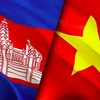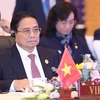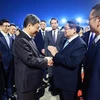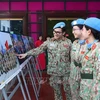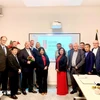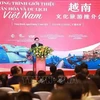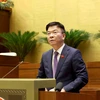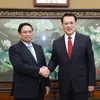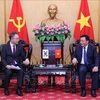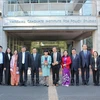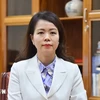ASEAN Member States are moving forward with cooperation and integration to build Southeast Asia into a region of peace, stability and development. The ASEAN Charter coming into effect has ushered in a new era of regional cooperation that would lead to the creation of a strong ASEAN Community by 2015 with three pillars – Political-Security Community, Economic Community and Socio-Cultural Community. ASEAN has been also boosting its cooperation with external partners to enhance broader peace, stability and development.
In realising the Blueprint for establishing ASEAN Political-Security Community, the Association has increased cooperation activities, establishing the ASEAN Defence Ministers Meeting (ADMM) besides other arrangements such as the Treaty of Amity and Cooperation (TAC), Southeast Asia Nuclear Weapons Free Zone (SEANWFZ), Declaration on the Conduct of Parties in the South China Sea (DOC), the ASEAN Regional Forum (ARF) to preserve security in the region, especially when it is faced with non-traditional security threats.
The achievements gained so far in the comprehensive cooperation among ASEAN Member States have laid a firm foundation and served as a driving force for their defence and military cooperation to develop, aiming to meet the 2015 community building goal. In the past years, ASEAN has continued to sustain channels of dialogue, interaction and cooperation among its defence forces through annual and regular meetings and events. As a result, the defence and military cooperation has gained more ground to grow in a substantive and effective direction.
The ADMM was founded in 2006 to be the highest ministerial defence and security consultative and cooperative mechanism for regional security issues among the ASEAN Member States. After four years of development, it has scored admirable progress and achievements in building confidence, consolidating solidarity, facilitating and coordinating the multi-facetted defence cooperation. Defence Ministers of ASEAN countries have had an annual exchange of views on regional and international security. Furthermore, ADMM has created a framework for the practical cooperation among ASEAN militaries on defence and security issues. Among other initiatives, ministers have adopted two concept papers, namely “ The Use of ASEAN Military Assets and Capacities in Humanitarian Assistance and Disaster Relief ” and “ ASEAN Defence Establishments and Civil Society Organizations (CSOs) Cooperation on Non-Traditional Security ”. The fourth ADMM, which was held in Vietnam in May 2010, further moved these initiatives forward by supporting the building of implementation roadmaps. The meeting aslo supported the idea of ASEAN cooperation in defence industry. More importantly, all the necessary legal basis for establishing the ADMM-Plus was finalized and adopted at the fourth ADMM, paving the way for the broadening of cooperation between ASEAN and its key external partners, pooling resources to deal with securitty challenges, contributing to the promotion of peace and stability in the region and assisting the ASEAN in community building effort.
Within the framework of ADMM, besides preparatory meetings as ADSOM and ADSOM WG, it is worth to mention the Track II Network of ASEAN Defence Institutions (NADI) as a supporting tool for the ADMM. Founded in 2007, NADI is a forum where scholars and reaseachers in ASEAN meet and exchange on defence and security matters that are relevant to ADMM, with a view to seeking innovative recommendations to ADMM. In addition, NADI facilitates closer relationship among ASEAN defence research institutions. The third NADI held in Vietnam in April 2010 after reviewing and assessing the situation, recommended for strengthening defence and military cooperation in a broader regional context.
In parallel with cooperation through defence channels, military-to-military cooperative activites have been conducted at various levels. ASEAN Chiefs of Defence Forces, Chiefs of Armies, Navies and Air Forces meet at annual or regular meetings such as ASEAN Chiefs of Defence Forces Informal Meeting - ACDFIM (since 2001), ASEAN Chiefs of Army Multilateral Meeting - ACAMM (since 2000), ASEAN Navy Interaction – ANI (since 2001), and ASEAN Air Force Chiefs Conference - AACC (since 2004). There is also ASEAN Military Intelligent Informal Meeting - AMIIM. All in all, the growth and expanding of military-to-military interaction and cooperation have contributed to building mutual confidence and understanding, cementing the solidarity among ASEAN defence forces.
In cognizant of increasing and more complicated non-traditional security challenges that face the region, ASEAN militaries are trying to gradually gather their efforts for a collective deal. The resolution of the seventh ACDFIM in March 2010 made it clear that militaries in ASEAN need to work closer together in response to non-traditional security concerns as terrorism, natural disasters, infectious diseases, food and energy security, climate change, human trafficking, illegal arms trade and piracy. At the seventh ACDFIM, ASEAN Chiefs of Defence Forces also agreed to consider the building of a mechanism for cooperative activities of humanitarian assistance and disaster relief (HADR). They adopted a 2- year workplan, covering annual meetings and seminars/workshops that aim to share experience and expertise in areas of maritime security, peacekeeping operations, counter-terrorism as well as exchange activities among ASEAN militaries. According to this workplan, the ASEAN Chiefs of Military Medical Meeting and a tabletop excersice will be held in 2011 for the first time. ACDFIM’s decisions are important in that they directly guide the activities of effective practical cooperation in the coming time. It is neccesary to mention socio-cultural exchanges among ASEAN young officers from Army, Air Force, with events like ASEAN Armies Rifle Meet and other sport tournaments.
Apart from cooperative activities under the multilateral frameworks, ASEAN militaries have engaged in several bilateral cooperative interactions such as exchange of delegation at different levels, education and training exchange, establishing hotlines of communication between navies, joint patrols both on land and at sea, and exercises of search and rescue.
With regard to external cooperative relations, ASEAN has been increasing the defence cooperation with its partners outside the region under the framework of ASEAN Regional Forum (ARF), specifically the ARF Security Policy Conference (ASPC), ARF Defence Officials’ Dialogue (DOD) and ARF Heads of Defence Universities/Colleges /Institutions Meeting (HDUCIM). The participation and engagement of defence officials in ARF-related meetings have received growing recognition as a positive contribution to the forum. In its year of ARF chairmanship, Viet Nam has organized four DoD and one ASPC meetings. At these meetings, participants had extensive discussions on regional security issues, taking stock of the role of defence establishments in the evolving regional security architecture and mapping out future plans for ARF defence cooperation which will boost the experience exchange in maritime security, HADR, natural disaster and climate change. Furthermore, ASEAN countries have increased defence dialogues with China and Japan so as to promote mutual understanding and trust.
The year 2010 has seen a breakthrough in ASEAN’s external defence cooperation with the establishment of the ADMM-Plus, the highest ministerial mechanism of consultation and cooperation between ASEAN and its key partners on defence and security issues. The ADMM-Plus aims to facilitate strategic dialogues among defence ministers and promote practical cooperation through leveraging resources, experience and expertise to collectively address common security challenges in the region. It is expected that the ADMM-Plus will add new values to ASEAN’s existing defence cooperation mechanisms, thus tangibly contributing to regional peace, stability and development as well as the building of ASEAN Community by 2015.
The defence and military cooperation within ASEAN and between ASEAN and its partners so far has been done through various, specific ways and means, which are in practical orientation and suitable with conditions and capabilities of participating countries. The momentum of ASEAN intra-cooperation has been maintained and increased and now is gearing for the enhanced effectiveness and improved capabilities. At the same time, the cooperation between ASEAN and its key Dialogue Partners has made a great leap forward with the realisation of ADMM-Plus. All these developments contribute to ensuring our regional security, peace, stability and development, substantively support for the building of ASEAN Community in general and ASEAN Political-Security Community in particular./.
